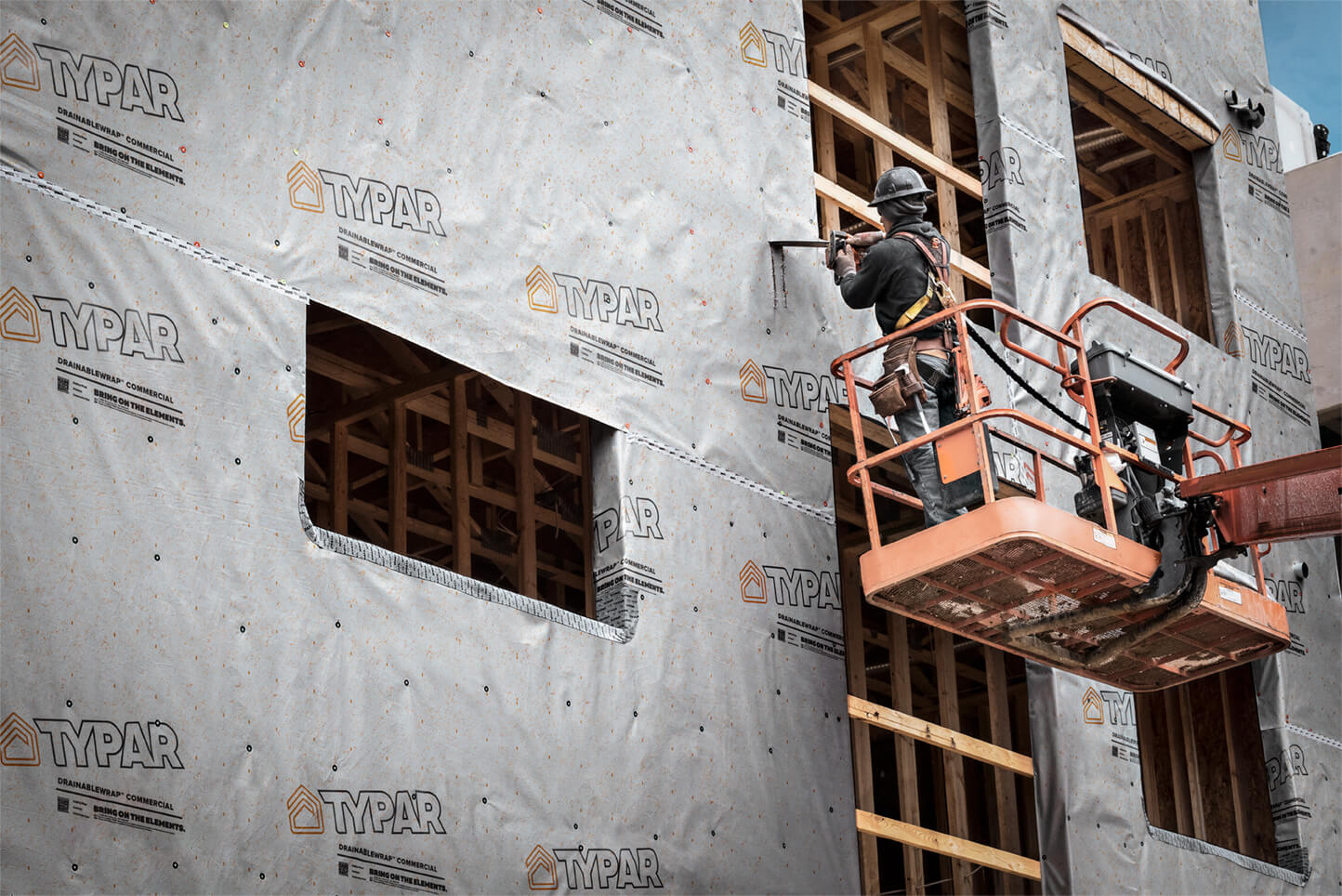
According to the National Multifamily Housing Council (NMHC), roughly one-third of all new housing construction in the U.S. is in the multifamily sector, and growth in multifamily housing doesn’t appear to be slowing anytime soon. In fact, the National Association of Home Builders (NAHB) reports that multifamily housing starts increased by 69% between 2010 and 2020.
This represents a significant opportunity for builders and contractors. However, multifamily construction also brings several unique challenges such as zoning and permitting regulations, land costs and availability, and the need to coordinate multiple subcontractors—all of which can add complexity and add weeks to project timelines.
While navigating the unique challenges of multifamily construction, working with a proven weather protection system can be a significant advantage. Here are a few questions to ask when selecting the right building wrap for your multifamily project:
If your building wrap can’t maintain its strength and performance under harsh job site conditions, the building envelope is liable to become compromised before the first tenant moves in.
One of the first things multifamily builders and contractors should look for in a building wrap is its tear strength. Heavy wind gusts can rip away fastened building wrap during construction, especially in high-rise applications. And let’s be honest—it doesn’t inspire a lot of confidence to drive up to a job site and see the building wrap torn away from the wall and flapping in the wind.
TYPAR MetroWrap™ has five times the tear strength of competing building wraps, so it is much less likely to tear or puncture during installation or because of exposure to weather conditions. Ultimately, this means the building envelope will remain intact and perform as intended for the life of the building.
Another factor to consider when evaluating the overall durability of a building wrap for multifamily construction is how resistant it will be to surfactants. Surfactants (surface active agents) are contaminants that lower the surface tension of a liquid, allowing it to penetrate deeper into the building wrap material. These contaminants can be found in water soluble extractives in wood cladding, as well as detergents, soaps, and other cleaning solutions used to power wash siding, so it’s likely the building wrap will be exposed to them at some point.
TYPAR building wraps are all engineered with a specialized coating that resists surfactants. In fact, third-party testing commissioned by The American Society of Heating, Refrigerating and Air-Conditioning Engineers (ASHRAE) showed that TYPAR resisted a power wash solution, while a competitor failed.
One of the primary performance attributes of a high-performance weather-resistant barrier (WRB) is its ability to stand up to UV exposure. This is a critical point of differentiation between weather barriers, as prolonged exposure to UV radiation can cause material degradation, leading to loss of tensile strength, delamination of surface layers and reduced water repellency of the WRB.
This is especially true in multifamily construction where there are already prolonged construction schedules that are often slowed by several factors. According to the NAHB, the average time to complete a multifamily construction project, from obtaining the necessary permits to final inspection, is around 15 months.
Many building wraps currently on the market only offer up to 120 days of UV resistance, which may not be enough to accommodate multifamily construction schedules. WRBs like TYPAR MetroWrap™, however, can be left exposed for up to 12 months with no UV degradation—more than any other product on the market.
According to the Environmental Protection Agency (EPA), the average American spends 93% of their life indoors. In the wake of the COVID-19 pandemic, as our homes increasingly do double duty as offices and classrooms, people have become more aware of indoor air quality issues than ever before.
Also, multifamily buildings are typically subject to stricter energy codes than single-family homes, and energy efficiency is essential for both environmental and economic reasons. Builders should pay attention to building envelope details such as insulation and air sealing to achieve optimal energy efficiency.
Building wraps protect healthy indoor air by acting as an air and moisture barrier, which is necessary to avoid mold issues and to maintain comfortable indoor temperatures and an energy-efficient building. However, builders and contractors should also consider whether the WRB material is permeable enough to allow any moisture that does enter the walls to escape. Building scientist Joseph Lstiburek advises builders to aim for 10-20 perms when specifying a building wrap, as this “sweet spot” achieves the desired balance of moisture protection and breathability.
The latest advancements in building wraps, including the newest TYPAR building wrap, TYPAR DrainableWrap™ Commercial, add an integrated layer of polypropylene fibers to create an effective drainage gap that channels wind-driven rain and bulk water away from structures four stories and above. And at 10 perms, it provides an ideal balance between moisture holdout and breathability.
Choosing the right building wrap for your multifamily project is essential for ensuring the longevity of the building and the health of its occupants. The durability of the building wrap, its ability to withstand prolonged UV exposure, and its effectiveness as an air and moisture barrier are all critical factors to consider.
TYPAR offers several high-performance building wraps ideal for any multifamily project. For developments up to four stories tall, TYPAR BuildingWrap™ offers the durability, UV resistance, and air and water holdout to protect your building from the elements. For projects over four stories, TYPAR MetroWrap has you covered with even greater tear strength and UV resistance. And for projects that require additional drainage to meet ASTM 2273 requirements, TYPAR DrainableWrap (up to four stories in height) and TYPAR DrainableWrap Commercial (four stories and above) can help you achieve greater than 90% drainage efficiency.
By choosing a proven, high-performance building wrap from TYPAR, you can ensure that your building will stand the test of time and provide a healthy, comfortable indoor environment for years to come.